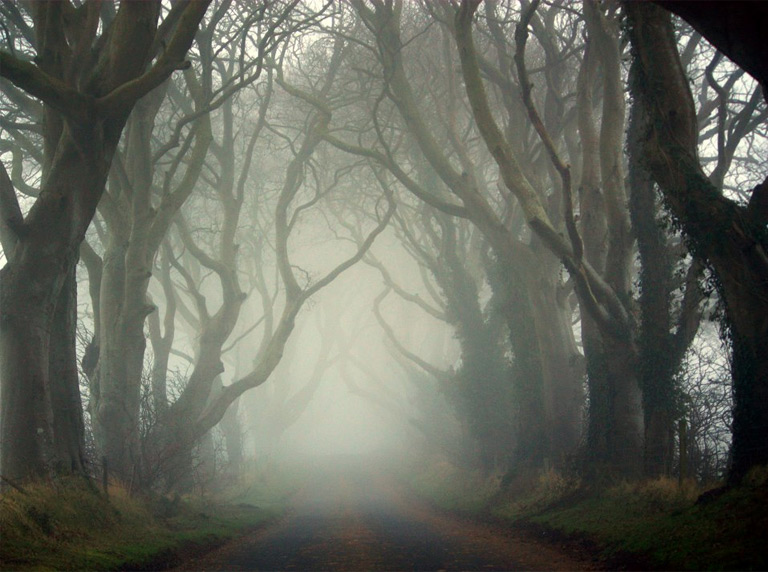Fagus - in bonsai, throughout history - a mystifying deciduous heavyhitter
There’s a dirt road in Northern Ireland, not particularly special at first, just an entrance to an old estate. Approaching it, you can see two rows of massive trees emerge from the landscape. Their corkscrew canopies billow out, up, and around, enveloping you in a kaleidoscopic tunnel of silvery arms and glowing moss.
The trees come alive. Each opaque trunk is elegantly marred with gnarls and scars, as if documenting a wild history. Each branch echoes the violent elements in which it fought the surrounding flora for a seat at the apex. These are European beech trees—Fagus sylvatica—mystifying deciduous heavyhitters.

If you know bonsai, you are probably obsessed with/terrified of these trees because they have a life of their own; they respond so quickly to your touch. If met with fastidious dedication and a dash of luck, you may live to develop a ‘perfect’ beech. And yet, if you have one rogue day where you get a little agro with the wire, your beech will take notes and remind you of that mistake for the rest of your measly life.
Beech is a natural predator. With thick trunks and dominant canopies, not much else besides fungi and ground vegetation can grow in the understory of a beech forest. Light simply can’t get through the colossal branching.

"European beech forests oncecovered 40% of the European continent."
European beech forests once covered 40% of the European continent. Being the first tree to reemerge after the last ice age, ancient beech forests once dominated the European landscape. Due to beech’s utility as a hardwood and Europe’s appetite for fuel, much of the old growth has been cut down. But in 2011, the primeval beech forests of Germany and the Carpathian Mountains were classified as a UNESCO world heritage site— a unique cache of ecological data akin to the Galapagos or the Great Barrier Reef.**
Beech has always been a European icon. Not only a fine-grained blonde bombshell utilized often in Scandinavian design and overall stellar hardwood, beech has been an archetypal influence for the entire Western World.

"The Old English word forbook and Beech were used interchangeably..."
For starters, beechmast, or the nuts made by beech, was a dietary staple for Stone Age band societies. The greek root for Fagus literally means edible. Beechmast is still used today to feed livestock in Europe.*
Not only as a source of sustenance, beech was a major player in the development of written Germanic languages. Early Anglo-Saxons used easily impressionable beechwood to carve runic tablets. This practice had such a significant cultural impact that it is reflected in language. The Old English word, boc, was used interchangeably to refer to both book and beech. Even today, the modern German words for book: buch and for beech: büche, are incredibly similar.*
The sensitivity of this tree’s bark that made it so perfect for carving Anglo-Saxon musings is also the reason why beech drives bonsai afficionados insane. You could cough on this tree and it would warp, let alone chopping branches off or wrapping it in malleable metal. And yet, why does it matter if a little scar shows up here or there? This is the fascinating source of tension with these trees in bonsai.

For the Japanese aesthetic, beech represents transcendent precision. A fully formed Japanese style beech is perfection incarnate. And not just like, “Oh what a pretty tree,” kind of perfection. It’s the, “did a Nordic god craft this in Asgard?” kind of perfection—because it’s so damn difficult.
This style seeks unblemished white bark on a thick trunk and a spacious, symmetrical, highly ramified canopy. The tree displayed by the Pacific Bonsai Museum at The Artisan’s Cup showcases the epitome of Japanese-style beech.

And then there are the Europeans, staying true to their roots. The ‘Western’ style for creating beech bonsai is akin to the trees along that atmospheric Irish road—craggy and fantastical— Little Red Riding Hood style. This aesthetic seeks to honor the wild incarnation of ancient beech—gnarls, hallows, and all.
Beech is at the fulcrum of opposing aesthetic styles in bonsai—traditional versus avant-garde, idealized perfection versus organic expression, classic form versus modern asymmetry. And while both styles are incredible in their own right, purist blood runs deep in the bonsai world.

Baby-smooth beech bark is an irresistible draw for a certain mind, mainly masochistic bonsai people. In a craft where the practitioner seeks to hide their hand on the tree—like ballet dancers who jump and land as if charged with helium—working on a tree so susceptible to damage is like dancing with a 30lb. headdress on, in wooden shoes, on a concrete floor.
The impracticality of this challenge is a homing beacon for the Mirai mindset. The idea of impossibility really gets us going. We recently made a Beech forest composition during a Mirai Live stream. This creation was so special for us because untarnished beech stock is a rare-find.
Relatively young deciduous forests of the Eastern United States, where everything grows on rock, inspired this composition. We wrestled with placement to find the balanced forest feel and concentrated on straighter lines of a hardwood forest. We saved the best for the best and placed the forest in a Tom Benda pot. What else would heighten the glow of those trunks but a hand-made, wood-fired, impeccably glazed European pot?

This Beech forest will become a Mirai superstar. We are totally infatuated, like hopeful honeymooners. We will be gentle with her; we will try to preserve her luminous bark. As our relationship grows with time, if she gets a few nicks and scratches, we will love her all the more. We will revel in her curves and textures, praising the iconic embodiment of such a species. She will toe that line between transfixing perfection and raw beauty, fully epitomizing the innovative Mirai-style.

